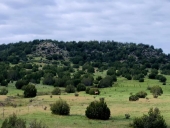
 1
1




Sometimes the answer is nothing





Sometimes the answer is nothing





Iterations are fine, we don't have to be perfect
My 2nd Location:Florida HardinessZone:10 AHS:10 GDD:8500 Rainfall:2in/mth winter, 8in/mth summer, Soil:Sand pH8 Flat




S Bengi wrote:1 sheep = 1/4 of a cow (250lbs)
So dad and mom sheep+babies = 1/2 of a cow (500lbs)
1 pig = 1/4 of a cow (250lbs)
So two pigs + babies = 1/2 of a cow (500lbs)
Momma cow (1000lbs) + baby(65lbs) = 1.065 cow.
So at this point we need enough pasture for '2 cows' (2000lbs)
Zone 8 Texas have 3 out of 12 months of 'winter" so we are going to need an additional 30% of 'pasture for a hay field.
So enough pasture for 2.6 cows.
According to the Texan government it takes 3acres to feed each cow on tame pastureland.
https://tpwd.texas.gov/landwater/land/habitats/post_oak/habitat_management/cow/
So 3acres X 2.6 = 7.8 acres
Less that 10 acres ..... Awesome
In the equation above we uses 2cow unit.
But as the baby calf turns into a yearling it will go up to 2.55 cow unit
(1000lbs momma cow + 600lbs yearling calf = 0.95 + 0.6= 1.55 cow unit)
So 2.55 cow unit * 1.33(winter hay) * 3acres/cow = 9.9 acres
We are still looking fine
Tame Pasture is still semi-wild, if you really put in the work you can bring the number to 1acres of super improved pasture per cow during the growing season (3/4 of the year) You will need another 30% for the winter.
 1
1




Sometimes the answer is nothing



 1
1




Iterations are fine, we don't have to be perfect
My 2nd Location:Florida HardinessZone:10 AHS:10 GDD:8500 Rainfall:2in/mth winter, 8in/mth summer, Soil:Sand pH8 Flat
 4
4




 *
*  3
3




Standing on the shoulders of giants. Giants with dirt under their nails
 2
2




It's never too late to start! I retired to homestead on the slopes of Mauna Loa, an active volcano. I relate snippets of my endeavor on my blog : www.kaufarmer.blogspot.com
 1
1




A build too cool to miss:Mike's GreenhouseA great example:Joseph's Garden
All the soil info you'll ever need:
Redhawk's excellent soil-building series











 1
1




It's never too late to start! I retired to homestead on the slopes of Mauna Loa, an active volcano. I relate snippets of my endeavor on my blog : www.kaufarmer.blogspot.com


 1
1




Trace Oswald wrote:In addition to the information above, consider getting your windbreak trees in place at the very beginning. They will have a huge effect on watering conditions and growth of your other plants.
For the sake of clarity, the Texas site that S Bengi mentioned earlier says that for one cow unit (momma and baby), 8 to 15 acres of native grass or 3 to 6 acres of tame pasture (Bermuda grass). If i were doing the math for my own site, i would estimate 10 acres to be on the safe side, and 15 acres for worst case scenario. Without natural water on site, i would try to create a large scale water catchment system using the house and barn roofs.
Iterations are fine, we don't have to be perfect
My 2nd Location:Florida HardinessZone:10 AHS:10 GDD:8500 Rainfall:2in/mth winter, 8in/mth summer, Soil:Sand pH8 Flat
 2
2




S Bengi wrote:
Trace Oswald wrote:In addition to the information above, consider getting your windbreak trees in place at the very beginning. They will have a huge effect on watering conditions and growth of your other plants.
For the sake of clarity, the Texas site that S Bengi mentioned earlier says that for one cow unit (momma and baby), 8 to 15 acres of native grass or 3 to 6 acres of tame pasture (Bermuda grass). If i were doing the math for my own site, i would estimate 10 acres to be on the safe side, and 15 acres for worst case scenario. Without natural water on site, i would try to create a large scale water catchment system using the house and barn roofs.
Based on the picture of the plot of land that the OP uploaded, over 50acres is needed for just 1 cow.
So I 100% expect the OP to irrigate his land. And to not even consider cows until 60months.
After he has built up his pasture with sheep and tilling the cover crop under.
Due to the fact that so much fossil water is going to have to be pumped up to grow grass, we might as well plant and water densely (1acre of pasture per cow) so as to minimize water lost. The biggest goal here will be to maximize the productivity of the soil and pasture, then we can do the cow and finally we can worry about homemade kefir cheese vs homemade blue cheese, (FYI: I am cheering for the kefir cheese)
The pasture is going to need alot of protection.
Windbreak, lower water needs, and cut erosion
Waterbreak, swales to let the rain soak in and to stop erosion
Herbivore-break (deer eating all that wonderful pasture and kale that was suppose to be for tomorrow)
Carnivore-break (coyote are a killer, so dogs and fencing and gun are needed)
Insect-break (chicken,ladybug,etc and others will help)
Herd Parasite, 30-day rotational grazing to break life-cycle
Etc, etc
A build too cool to miss:Mike's GreenhouseA great example:Joseph's Garden
All the soil info you'll ever need:
Redhawk's excellent soil-building series





 2
2




S Bengi wrote:I second this idea of keeping the pasture plants+ducks+chicken+fish semi-wild and more for pest management/wildlife and not for human consumption.
The fruit/nut/berry plants and fish pond, honey hive, vegetable garden, chicken/etc that is meant to be eaten by humans should be kept inside double fenced 2.5 acres area by the house. This area is smaller and easier to protect/fence/observe/water/maintain, esp as we age in place.
 2
2




 2
2




![Filename: 20181117_103206-640x480.jpg
Description: [Thumbnail for 20181117_103206-640x480.jpg]](/t/96010/a/67768/20181117_103206-640x480.jpg)
Sometimes the answer is nothing

 2
2




![Filename: bb984b597012fa385edff5b5dc049dd4l-m0xd-w480_h480_q80.jpg
Description: [Thumbnail for bb984b597012fa385edff5b5dc049dd4l-m0xd-w480_h480_q80.jpg]](/t/96010/a/67788/bb984b597012fa385edff5b5dc049dd4l-m0xd-w480_h480_q80.jpg)
![Filename: bb984b597012fa385edff5b5dc049dd4l-m2xd-w480_h480_q80.jpg
Description: [Thumbnail for bb984b597012fa385edff5b5dc049dd4l-m2xd-w480_h480_q80.jpg]](/t/96010/a/67789/bb984b597012fa385edff5b5dc049dd4l-m2xd-w480_h480_q80.jpg)
![Filename: bb984b597012fa385edff5b5dc049dd4l-m3xd-w480_h480_q80.jpg
Description: [Thumbnail for bb984b597012fa385edff5b5dc049dd4l-m3xd-w480_h480_q80.jpg]](/t/96010/a/67790/bb984b597012fa385edff5b5dc049dd4l-m3xd-w480_h480_q80.jpg)
![Filename: bb984b597012fa385edff5b5dc049dd4l-m9xd-w480_h480_q80.jpg
Description: [Thumbnail for bb984b597012fa385edff5b5dc049dd4l-m9xd-w480_h480_q80.jpg]](/t/96010/a/67791/bb984b597012fa385edff5b5dc049dd4l-m9xd-w480_h480_q80.jpg)
![Filename: bb984b597012fa385edff5b5dc049dd4l-m18xd-w480_h480_q80.jpg
Description: [Thumbnail for bb984b597012fa385edff5b5dc049dd4l-m18xd-w480_h480_q80.jpg]](/t/96010/a/67792/bb984b597012fa385edff5b5dc049dd4l-m18xd-w480_h480_q80.jpg)
 1
1




Sometimes the answer is nothing





A build too cool to miss:Mike's GreenhouseA great example:Joseph's Garden
All the soil info you'll ever need:
Redhawk's excellent soil-building series









wayne fajkus wrote:Are there animals grazing currently? Its amazing how you can see straight through it at ground level. If not, they must have been super fanatical about trimming trees and under brush.




Randy Coffman wrote:I
Believe me, I want that 23ish acre place, but the cost is too great I think. I want our home to be a blessing, not a curse.
.
"But if it's true that the only person over whom I have control of actions is myself, then it does matter what I do. It may not matter a jot to the world at large, but it matters to me." - John Seymour






Iterations are fine, we don't have to be perfect
My 2nd Location:Florida HardinessZone:10 AHS:10 GDD:8500 Rainfall:2in/mth winter, 8in/mth summer, Soil:Sand pH8 Flat




"may your experience be fruit for all those who follow"
 2
2




A build too cool to miss:Mike's GreenhouseA great example:Joseph's Garden
All the soil info you'll ever need:
Redhawk's excellent soil-building series









Trace Oswald wrote:
I would caution again against getting any large animals until you are pretty well established on the land.
Get up to speed on that first before getting large animals. They add a lot of responsibility and work, and you owe it to living things to treat them well. Obviously, if you have experience raising animals, the situation is different. .

"But if it's true that the only person over whom I have control of actions is myself, then it does matter what I do. It may not matter a jot to the world at large, but it matters to me." - John Seymour








Standing on the shoulders of giants. Giants with dirt under their nails










 2
2




It's never too late to start! I retired to homestead on the slopes of Mauna Loa, an active volcano. I relate snippets of my endeavor on my blog : www.kaufarmer.blogspot.com






Iterations are fine, we don't have to be perfect
My 2nd Location:Florida HardinessZone:10 AHS:10 GDD:8500 Rainfall:2in/mth winter, 8in/mth summer, Soil:Sand pH8 Flat
 1
1








Getting a lgd will be an option. Not sure what breed since great pyrenees would probably hate life in the Texas summer.
Standing on the shoulders of giants. Giants with dirt under their nails




 4
4




Idle dreamer




Tyler Ludens wrote:Is there a self-sufficiency plan for paying for all of this? Will you have a home business, or work outside the home?
Without a plan for income to pay expenses, it's going to be difficult to build up such a large and complex operation. You mention times of crisis and dire straits; the most likely crises any of us will face in life are loss of job and serious illness. It's important to include those as part of a holistic plan for one's life, in my opinion and experience. It's very difficult to anticipate just what The Fates (or the Great God Murphy) hold in store.
 3
3




A build too cool to miss:Mike's GreenhouseA great example:Joseph's Garden
All the soil info you'll ever need:
Redhawk's excellent soil-building series











 3
3




It's never too late to start! I retired to homestead on the slopes of Mauna Loa, an active volcano. I relate snippets of my endeavor on my blog : www.kaufarmer.blogspot.com






Iterations are fine, we don't have to be perfect
My 2nd Location:Florida HardinessZone:10 AHS:10 GDD:8500 Rainfall:2in/mth winter, 8in/mth summer, Soil:Sand pH8 Flat
 1
1




 1
1




Idle dreamer

|
This tiny ad is wafer thin:
heat your home with yard waste and cardboard
https://freeheat.info
|





